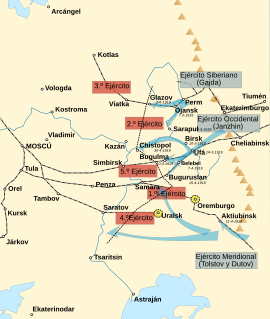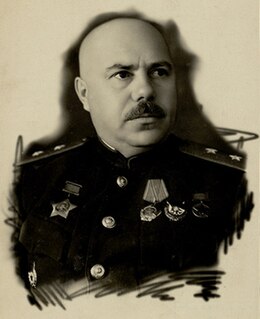
The 16th Army was a field army of the Red Army during the Russian Civil War era. It was originally formed as the Western Army on November 15, 1918, by the Russian SFSR for the purpose of recovering territories lost by the Russian Empire during the First World War and establishing Soviet republics in those territories. The Western Army engaged various local forces from the Baltic States, Belarus, Poland and Ukraine, and its actions contributed to starting the Polish–Soviet War of 1919–1920. The army fought in the Polish–Soviet War under the command of Nikolai Sollogub and advanced westwards into Poland in July 1920 before being thrown back during the Battle of Warsaw in August. The army retreated east into Belarus and was disbanded in May 1921.

Sergei Nikolaievich Wojciechowski was a Colonel of the Imperial Russian Army, Major-General in the White movement, and Czechoslovak Army general. He was a participant of the Great Siberian Ice March.
The 21st Rifle Division was an infantry division of the Russian Soviet Federative Socialist Republic and then the Soviet Union's Red Army, active between 1918 and 1945.
Izhevsk–Votkinsk Uprising was an anti-Bolshevik uprising in the Prikamye region during the Civil War in Russia.
The Perm Operation was a military operation during the Russian Civil War.

The Spring Offensive of the Russian Army was an offensive of the White Army of the White movement led by Alexander Kolchak on the Eastern Front of the Russian Civil War, between March and April 1919.

The Red Banner Ural Military District was an operational–strategic territorial association of the Armed Forces of the Soviet Union and the Russian Federation, which existed in 1918–1922, 1935–1989 and 1992–2001.
The 1st Middle Siberian Corps was one of the main formations of the Siberian Army during the Russian Civil War. It was created on June 12, 1918, under the command of Lieutenant Colonel Anatoly Pepelyayev.

The Southern Front was a front of the Red Army during the Russian Civil War, formed twice.
The 9th Army was a field army of the Red Army during the Russian Civil War which existed from October 3, 1918 until June 22, 1921.
The 10th Army was a field army of the Red Army during the Russian Civil War which existed from October 3 1918 until July 1920. It was formed from the troops operating in the area of Tsaritsyn and Kamyshin. On May 4, 1920 it was renamed the 10th Terek Army. It was dissolved in July 1920. It was part of the Southern Front, the South-Eastern Front and the Caucasian Front.

The August counter-offensive of the Southern Front was an offensive during the Russian Civil War by the troops of the Southern Front of the Red Army against the White Guard troops of Anton Denikin. Combat operations were conducted by two offensive groups, the main blow was aimed towards the Don region. The troops of the Red Army were unable to carry out the assigned task, but their actions delayed the subsequent offensive of Denikin's army.
Vasily Ivanovich Shorin was a Soviet military commander, who commanded several military units of the Red Army during the Russian Civil War.
The 1st Army was a field army of the Red Army during the Russian Civil War. The 1st Army was formed twice. The first formation was between the beginning of March 1918 and May as a reaction to the Austro-German occupation of Ukraine. The second formation was created on June 19, 1918, as a part of the Eastern Front and from August 15, 1919 as a part of the Turkestan Front. The Army was disbanded in January 1921.
The 5th Army was a field army of the Red Army during the Russian Civil War. The 5th Army was formed four times. The first formation was between the beginning of March 1918 and April as a reaction to the Austro-German occupation of Ukraine. The second formation was created between April 1918 and 23 June 1918 to defend Tsaritsyn, the third formation between August 16, 1918 and September 6, 1922, as a part of the Eastern Front and the fourth formation between November 16, 1922 and June 1924 in the Far East.
The 3rd Army was a field army of the Red Army during the Russian Civil War. The 3rd Army was formed three times.
The 4th Army was a field army of the Red Army during the Russian Civil War, which was formed 4 times between the beginning of March 1918 and March 1921.
The Ural Separate Army was a military formation of the White Army during the Russian Civil War, which operated in the Volga region and the Southern Urals and was formed on December 28, 1918 from units of the Ural Cossack Army and other military units within the Urals Region.

The Russian State was a state proclaimed by the Act of the Ufa State Conference of September 23, 1918 “On the formation of the all-Russian supreme power” in the name of “restoring state unity and independence of Russia” affected by the revolutionary events of 1917, the establishment of Soviet power and the signing of the treaty of Brest-Litovsk with Germany.

Pyotr Fyodorovich Malyshev was a Soviet Army lieutenant general who held field army command during World War II.







